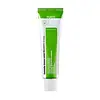What's inside
What's inside
 Key Ingredients
Key Ingredients

 Benefits
Benefits

 Concerns
Concerns

 Ingredients Side-by-side
Ingredients Side-by-side

Water
Skin ConditioningHydrogenated Polyisobutene
EmollientDimethicone 1%
EmollientGlycerin
HumectantButyrospermum Parkii Butter
Skin ConditioningPanthenol
Skin ConditioningAluminum Starch Octenylsuccinate
AbsorbentButylene Glycol
HumectantPropanediol
SolventCetyl PEG/PPG-10/1 Dimethicone
EmulsifyingTrihydroxystearin
Skin ConditioningZinc Gluconate
Skin ConditioningMadecassoside
AntioxidantManganese Gluconate
Skin ConditioningSilica
AbrasiveAluminum Hydroxide
EmollientMagnesium Sulfate
Disodium EDTA
Copper Gluconate
Skin ConditioningCitric Acid
BufferingAcetylated Glycol Stearate
EmollientPolyglyceryl-4 Isostearate
EmulsifyingTocopherol
AntioxidantPentaerythrityl Tetra-Di-T-Butyl Hydroxyhydrocinnamate
AntioxidantSodium Benzoate
MaskingPhenoxyethanol
PreservativeChlorhexidine Digluconate
AntimicrobialTitanium Dioxide
Cosmetic ColorantWater, Hydrogenated Polyisobutene, Dimethicone 1%, Glycerin, Butyrospermum Parkii Butter, Panthenol, Aluminum Starch Octenylsuccinate, Butylene Glycol, Propanediol, Cetyl PEG/PPG-10/1 Dimethicone, Trihydroxystearin, Zinc Gluconate, Madecassoside, Manganese Gluconate, Silica, Aluminum Hydroxide, Magnesium Sulfate, Disodium EDTA, Copper Gluconate, Citric Acid, Acetylated Glycol Stearate, Polyglyceryl-4 Isostearate, Tocopherol, Pentaerythrityl Tetra-Di-T-Butyl Hydroxyhydrocinnamate, Sodium Benzoate, Phenoxyethanol, Chlorhexidine Digluconate, Titanium Dioxide
Centella Asiatica Extract
CleansingWater
Skin ConditioningCaprylic/Capric Triglyceride
MaskingGlycerin
HumectantSqualane
EmollientCetearyl Alcohol
EmollientButylene Glycol
Humectant1,2-Hexanediol
Skin ConditioningNiacinamide
SmoothingMacadamia Ternifolia Seed Oil
EmollientButyrospermum Parkii Butter Extract
Skin ConditioningHydrogenated Lecithin
EmulsifyingTribehenin
EmollientStearic Acid
CleansingBehenic Acid
CleansingArgania Spinosa Kernel Oil
EmollientTromethamine
BufferingSpent Grain Wax
Skin ConditioningCarbomer
Emulsion StabilisingCaprylyl Glycol
EmollientTremella Fuciformis Extract
HumectantSodium Hyaluronate
HumectantPerilla Ocymoides Seed Extract
AntioxidantHamamelis Virginiana Extract
AntiseborrhoeicBetaine
HumectantBeta-Glucan
Skin ConditioningCitrus Aurantium Bergamia Fruit Oil
MaskingXanthan Gum
EmulsifyingSodium Carbomer
Emulsion StabilisingHydroxyethylcellulose
Emulsion StabilisingAdenosine
Skin ConditioningLavandula Angustifolia Oil
MaskingAsiaticoside
AntioxidantAsiatic Acid
Skin ConditioningPhytosphingosine
Skin ConditioningCeramide NP
Skin ConditioningMadecassic Acid
Skin ConditioningTocopherol
AntioxidantCentella Asiatica Extract, Water, Caprylic/Capric Triglyceride, Glycerin, Squalane, Cetearyl Alcohol, Butylene Glycol, 1,2-Hexanediol, Niacinamide, Macadamia Ternifolia Seed Oil, Butyrospermum Parkii Butter Extract, Hydrogenated Lecithin, Tribehenin, Stearic Acid, Behenic Acid, Argania Spinosa Kernel Oil, Tromethamine, Spent Grain Wax, Carbomer, Caprylyl Glycol, Tremella Fuciformis Extract, Sodium Hyaluronate, Perilla Ocymoides Seed Extract, Hamamelis Virginiana Extract, Betaine, Beta-Glucan, Citrus Aurantium Bergamia Fruit Oil, Xanthan Gum, Sodium Carbomer, Hydroxyethylcellulose, Adenosine, Lavandula Angustifolia Oil, Asiaticoside, Asiatic Acid, Phytosphingosine, Ceramide NP, Madecassic Acid, Tocopherol
 Reviews
Reviews

Alternatives
Ingredients Explained
These ingredients are found in both products.
Ingredients higher up in an ingredient list are typically present in a larger amount.
Butylene Glycol (or BG) is used within cosmetic products for a few different reasons:
Overall, Butylene Glycol is a safe and well-rounded ingredient that works well with other ingredients.
Though this ingredient works well with most skin types, some people with sensitive skin may experience a reaction such as allergic rashes, closed comedones, or itchiness.
Learn more about Butylene GlycolGlycerin is already naturally found in your skin. It helps moisturize and protect your skin.
A study from 2016 found glycerin to be more effective as a humectant than AHAs and hyaluronic acid.
As a humectant, it helps the skin stay hydrated by pulling moisture to your skin. The low molecular weight of glycerin allows it to pull moisture into the deeper layers of your skin.
Hydrated skin improves your skin barrier; Your skin barrier helps protect against irritants and bacteria.
Glycerin has also been found to have antimicrobial and antiviral properties. Due to these properties, glycerin is often used in wound and burn treatments.
In cosmetics, glycerin is usually derived from plants such as soybean or palm. However, it can also be sourced from animals, such as tallow or animal fat.
This ingredient is organic, colorless, odorless, and non-toxic.
Glycerin is the name for this ingredient in American English. British English uses Glycerol/Glycerine.
Learn more about GlycerinTocopherol (also known as Vitamin E) is a common antioxidant used to help protect the skin from free-radicals and strengthen the skin barrier. It's also fat soluble - this means our skin is great at absorbing it.
Vitamin E also helps keep your natural skin lipids healthy. Your lipid skin barrier naturally consists of lipids, ceramides, and fatty acids. Vitamin E offers extra protection for your skin’s lipid barrier, keeping your skin healthy and nourished.
Another benefit is a bit of UV protection. Vitamin E helps reduce the damage caused by UVB rays. (It should not replace your sunscreen). Combining it with Vitamin C can decrease sunburned cells and hyperpigmentation after UV exposure.
You might have noticed Vitamin E + C often paired together. This is because it is great at stabilizing Vitamin C. Using the two together helps increase the effectiveness of both ingredients.
There are often claims that Vitamin E can reduce/prevent scarring, but these claims haven't been confirmed by scientific research.
Learn more about TocopherolWater. It's the most common cosmetic ingredient of all. You'll usually see it at the top of ingredient lists, meaning that it makes up the largest part of the product.
So why is it so popular? Water most often acts as a solvent - this means that it helps dissolve other ingredients into the formulation.
You'll also recognize water as that liquid we all need to stay alive. If you see this, drink a glass of water. Stay hydrated!
Learn more about Water